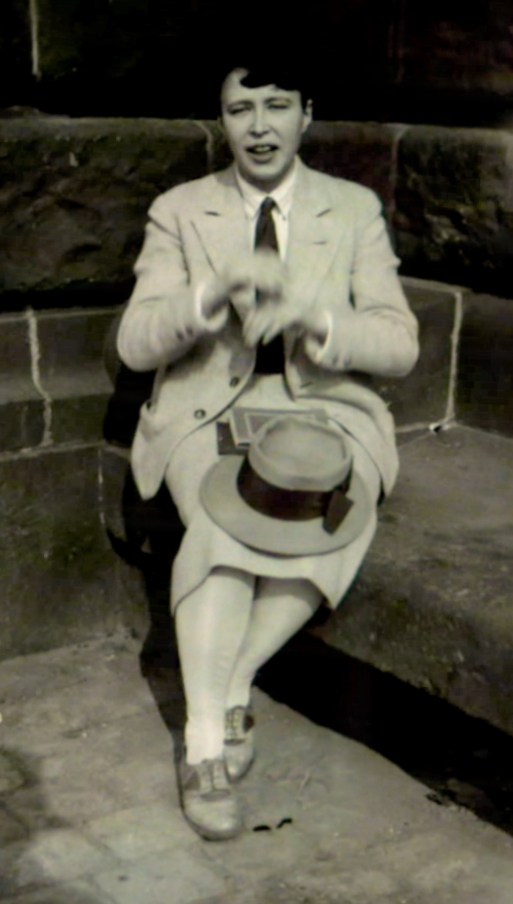BURIED TOGETHER
Husband
Clem Haizelden, Partner
Toto Koopman
Queer Places:
Bolton Studios, 17B Gilston Rd, Kensington, London SW10 9SJ, UK
Hanover Gallery, 32a St George St, Mayfair, London W1S 2FL, UK
Le Case dei Setti Mulini, Panarea, 98050 Lipari, Province of Messina
East Finchley Cemetery, 122 E End Rd, London N2 0RZ, Regno Unito
 Erica
Brausen (31 January 1908 – 16 December 1992), was an art dealer and gallerist
who established the Hanover Gallery in London in 1946 and was an early
champion of several influential contemporary artists, most notably
Francis Bacon.[1]
Erica
Brausen (31 January 1908 – 16 December 1992), was an art dealer and gallerist
who established the Hanover Gallery in London in 1946 and was an early
champion of several influential contemporary artists, most notably
Francis Bacon.[1]
Brausen was born in Düsseldorf to a father who was a merchant and the
master of the local fox-hounds. Brausen left Germany in the early 1930s for
Paris where she rented a room in Montparnasse. There she became friends with
many of the artists living in the area including Joan Miró and Alberto
Giacometti. In 1935 Brausen moved to Majorca, where she ran a bar popular with
artists, writers and visiting sailors. She used these contacts to assist
Jewish and socialist friends in escaping from Franco's forces during the
Spanish Civil War.[1]
She persuaded a US Navy submarine captain to take Michel Leiris and his family
to safety in Marseille. Brausen herself escaped on a fishing boat and arrived,
penniless, in England at the start of World War II.[2]
Brausen had a marriage of convenience to artist
Clem Haizelden, the lover of her landlord
at Bolton Studios, Raoh Schorr. Clem
Haizelden, lost touch with his entire family after 1951, his little sister, an
artist herself, married the sculptor William Tucker. Clem and Erica continued
to see each other in London and they never divorced.
In London, Brausen began organising small art exhibitions, often in artist
studios, but as a German national she encountered many difficulties and
restrictions. A gay artist friend married her which allowed her to work
legally and she, later, obtained a job at The Redfern Gallery. In 1946, with
the financial support of an American banker she had met at a party, Brausen
opened the Hanover Gallery in St. George Street off Hanover Square in central
London with a solo exhibition of works by Graham Sutherland.[3]
From 1946 until its closure in 1973, the Hanover Gallery was among the most
influential galleries in Europe. Brausen had bought a number of Francis Bacon
early works, including Painting (1946), and he held his first one-man
show at the Hanover in November 1947. Brausen became Alberto Giacometti's
principal dealer in London, selling more than seventy of his works over the
lifetime of the Gallery.[2]
Exhibitions at the Hanover included works by
Lucian Freud,
Marcel Duchamp and Max Ernst. Works by Henry Moore regularly featured in the
Hanovers' annual sculpture shows.[1]
Brausen was a lesbian and for most of her life her partner was
Catharina Koopman,
known as 'Toto', a one-time Chanel model and film actress. The two met in 1945
in Ascona, Switzerland, where Koopman was recuperating after surriving seven
months in the Ravensbrück concentration camp. Koopman had been sent there
after she was caught spying for the Italian Resistance during the Second World
War. She had been caught on two previous occasions and escaped both times but
she was captured a third time in October 1944 in Venice and quickly deported
to the camp. Koopman helped Brausen run the Hanover and the two women lived,
openly, together until Koopman's death in 1991.[4][5]
Brausen died in Hanover assistant Jean-Yves Mock’s arms and was buried with Koopman alongside her friend, the American publisher
Jane Heap. a significant figure in the
development and promotion of literary modernism.
My published books:


BACK TO HOME PAGE

- https://en.wikipedia.org/wiki/Erica_Brausen
 Erica
Brausen (31 January 1908 – 16 December 1992), was an art dealer and gallerist
who established the Hanover Gallery in London in 1946 and was an early
champion of several influential contemporary artists, most notably
Francis Bacon.[1]
Erica
Brausen (31 January 1908 – 16 December 1992), was an art dealer and gallerist
who established the Hanover Gallery in London in 1946 and was an early
champion of several influential contemporary artists, most notably
Francis Bacon.[1]

